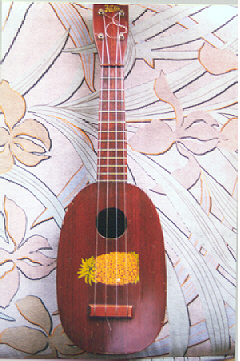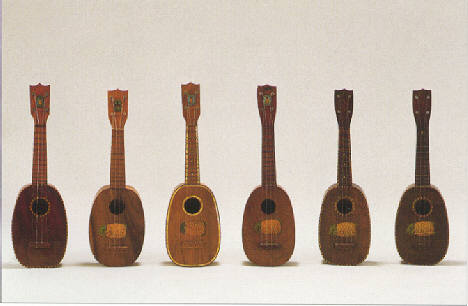![]()

In Hawaii in the 1920s, at the height of the ukulele boom, there were several ukulele manufacturers, including Kumalae, Nunes, and Kamaka. However, when the ukulele boom ended in the 1930s and 40s, all of these went out of business except for one...Kamaka Hawaii.

It was in 1916 that a young apprentice to Manuel Nunes decided to start his own ukulele business in the basement of his house in Kaimuki. This young man was Samuel Kamauela Kamaka and he started out making a dozen ukuleles per week and selling them for $5 apiece. By 1921 he was able to hire employees and move out of his basement to a workshop. By the late 20s there were an estimated 15 ukulele manufacturers in Hawaii. The competition was stiff, but a pineapple shaped ukulele designed by Sam Kamaka, Sr. helped his company outlast his competitors and within a decade, Kamaka was the only Hawaiian ukulele maker left. In 1959, the same year Hawaii became a state, Kamaka Hawaii moved to their present location at 550 South Street in Honolulu where Sam Kamaka's sons, Sam Jr. and and Fred, are managing operations.

One of the most interesting facts about Kamaka is that more then half of their employees are hearing impaired. As it turns out, this is not a handicap in the making of fine musical instruments. In fact, these ukulele makers are able to use their heightened sense of touch to determine the exact thickness that the koa should be by thumping the wood and feeling the vibrations with their fingers.

The body of the famous "painted pineapple".

Over the years, Kamaka Hawaii has created instruments for comedians Laurel and Hardy, singer Tiny Tim, entertainer Arthur Godfrey, astronaut Scott Carpenter, Prince and Princess Takamatsu of Japan, the King of Tonga, and many top entertainers in Hawaii, including Auntie Genoa Keawe, Peter Moon and Israel Kamakawiwo'ole.

Today, Kamaka Hawaii, Inc. manufactures about 3,000 instruments per year and they have a backlog of over 12 months. Almost all their ukuleles are made out of Hawaiian koa wood, that wonderful shimmering exotic wood with it's unusual curly grain. All sizes are made, including soprano, concert, tenor and baritone. In addition, the tenor sizes are made in 4, 6 and 8 stringed varieties. It was Sam Kamaka, Jr. who invented the 6 string Lili'u (named after Queen Lili'uokalani) in 1959, in celebration of Hawaii's statehood. Then, in 1976, he came up with the modern 8 string tenor Lili'u, in celebration of America's Bicentennial. Who knows what new design he'll come up with for the millenium!

From raw materials to finished ukuleles, Kamaka ukes are made in Hawaii by Hawaiian craftsmen.
Here is the current line of Kamaka ukuleles (except the baritone and 4 string tenor), courtesy of Mandolin Brothers...

Back row: 6 string Lili'u tenor, 8 string Lili'u tenor, Ohta-San concert model. Front row: concert, pineapple, soprano.

The best place to buy Kamakas are right at the factory, at 550 South Street in Honolulu. They sell "seconds", which are perfectly fine ukuleles with slight flaws, such as a small knot in the wood or some other blemish. Call Kamaka to see on which days they are selling their "seconds". Kamaka ukuleles are not easy to find outside of Hawaii, but you can find them on the internet at Bounty Music and Mandolin Brothers.

Rare Kamaka advertisement from 1958.
Home | Uke Players
| Beautiful Ukes | Uke History
| Martin Ukes | Kamaka Ukes |
Kamaka Tour | Uke Friends | Brudda IZ | Ukulele Ike | Uke Music
![]()